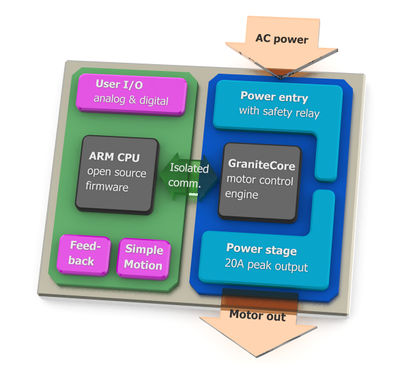Difference between revisions of "GraniteCore"
From Granite Devices Knowledge Wiki
| [checked revision] | [checked revision] |
| Line 21: | Line 21: | ||
*Display device state via digital outputs and [[Argon LED indicators|LED indicators]] | *Display device state via digital outputs and [[Argon LED indicators|LED indicators]] | ||
*Based on ARM Cortex M3 microcontroller running at 120 MHz | *Based on ARM Cortex M3 microcontroller running at 120 MHz | ||
| − | + | ===Benefits of the architecture=== | |
| − | I/O side CPU has open source firmware allowing end users to implement additional drivers for feedback devices and/or create stand-alone servo drive applications without external [[Controller]]. | + | *I/O side CPU has [[Argon open source firmware|open source firmware]] allowing end users to implement additional drivers for feedback devices and/or create stand-alone servo drive applications without external [[Controller]]. |
| + | *Isolation between the processors is more cost efficient and flexible than isolation individual I/O signals directly to high voltage side (a typical solution in the market) | ||
[[Category:Technology]] | [[Category:Technology]] | ||
[[Category:Glossary]] | [[Category:Glossary]] | ||
[[Category:Argon features]] | [[Category:Argon features]] | ||
Revision as of 16:45, 24 April 2014
GraniteCore a.k.a. GC is the motor control core developed for Argon (servo drive).
Argon architecture
Argon consists dual CPU architecture which run in tight synchronism and have different tasks:
- GraniteCore
- Servo control functionality for torque, velocity and position control
- High dynamic range torque control
- Dead-time distortion correction
- Control power stage directly
- Axis homing functionality
- Virtual scope to capture variables at high sample rate
- Galvanically isolated from I/O side
- Based on Digital Signal Controller
- I/O side CPU
- Feed GraniteCore with real time data consisting
- Position & velocity feedback device data
- State of physical inputs (enable, clear faults, hall sensors etc)
- SimpleMotion V2 commands to read/write parameters
- Interface different types feedback devices and setpoint inputs
- Handle SimpleMotion V2 communication
- Display device state via digital outputs and LED indicators
- Based on ARM Cortex M3 microcontroller running at 120 MHz
Benefits of the architecture
- I/O side CPU has open source firmware allowing end users to implement additional drivers for feedback devices and/or create stand-alone servo drive applications without external Controller.
- Isolation between the processors is more cost efficient and flexible than isolation individual I/O signals directly to high voltage side (a typical solution in the market)
